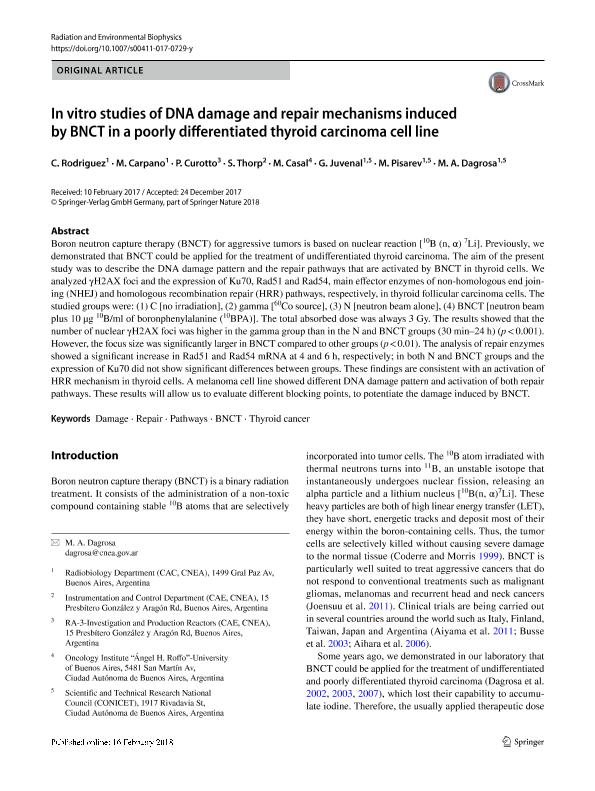Artículo
In vitro studies of DNA damage and repair mechanisms induced by BNCT in a poorly differentiated thyroid carcinoma cell line
Rodriguez, C.; Carpano, M.; Curotto, P.; Thorp, S.; Casal, M.; Juvenal, Guillermo Juan ; Pisarev, Mario Alberto
; Pisarev, Mario Alberto ; Dagrosa, María Alejandra
; Dagrosa, María Alejandra
 ; Pisarev, Mario Alberto
; Pisarev, Mario Alberto ; Dagrosa, María Alejandra
; Dagrosa, María Alejandra
Fecha de publicación:
05/2018
Editorial:
Springer
Revista:
Radiation and Environmental Biophysics
ISSN:
0301-634X
Idioma:
Inglés
Tipo de recurso:
Artículo publicado
Clasificación temática:
Resumen
Boron neutron capture therapy (BNCT) for aggressive tumors is based on nuclear reaction [10B (n, α) 7Li]. Previously, we demonstrated that BNCT could be applied for the treatment of undifferentiated thyroid carcinoma. The aim of the present study was to describe the DNA damage pattern and the repair pathways that are activated by BNCT in thyroid cells. We analyzed γH2AX foci and the expression of Ku70, Rad51 and Rad54, main effector enzymes of non-homologous end joining (NHEJ) and homologous recombination repair (HRR) pathways, respectively, in thyroid follicular carcinoma cells. The studied groups were: (1) C [no irradiation], (2) gamma [60Co source], (3) N [neutron beam alone], (4) BNCT [neutron beam plus 10 µg 10B/ml of boronphenylalanine (10BPA)]. The total absorbed dose was always 3 Gy. The results showed that the number of nuclear γH2AX foci was higher in the gamma group than in the N and BNCT groups (30 min–24 h) (p < 0.001). However, the focus size was significantly larger in BNCT compared to other groups (p < 0.01). The analysis of repair enzymes showed a significant increase in Rad51 and Rad54 mRNA at 4 and 6 h, respectively; in both N and BNCT groups and the expression of Ku70 did not show significant differences between groups. These findings are consistent with an activation of HRR mechanism in thyroid cells. A melanoma cell line showed different DNA damage pattern and activation of both repair pathways. These results will allow us to evaluate different blocking points, to potentiate the damage induced by BNCT.
Palabras clave:
BNCT
,
DAMAGE
,
PATHWAYS
,
REPAIR
,
THYROID CANCER
Archivos asociados
Licencia
Identificadores
Colecciones
Articulos(SEDE CENTRAL)
Articulos de SEDE CENTRAL
Articulos de SEDE CENTRAL
Citación
Rodriguez, C.; Carpano, M.; Curotto, P.; Thorp, S.; Casal, M.; et al.; In vitro studies of DNA damage and repair mechanisms induced by BNCT in a poorly differentiated thyroid carcinoma cell line; Springer; Radiation and Environmental Biophysics; 57; 2; 5-2018; 143-152
Compartir
Altmétricas



